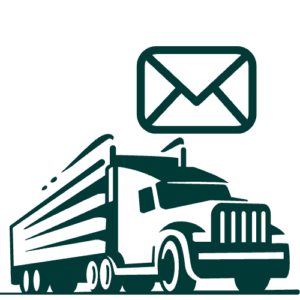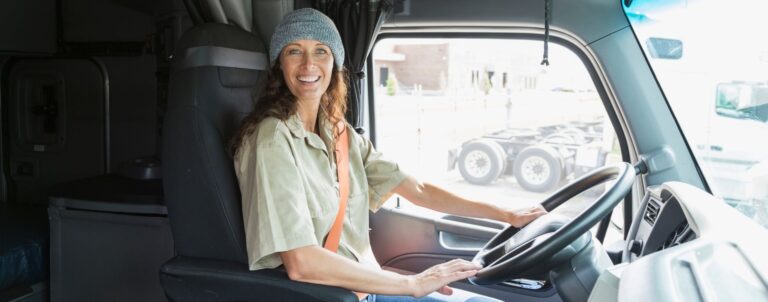FMCSA to End MCs, the Future of Renewable Fuel and EVs + Freight Market Update | Ep 6
Gurvir and Caroline cover the market for electric trucks and renewable diesel and the new registration system the FMCSA is building to combat fraud, as well as the weekly freight market and fuel price updates.
Send your comments and questions to hello@bobtail.com to be featured in a future episode!
Links & Resources:
National average diesel prices
Average diesel prices by state
National truckload index, Freightwaves
DAT Trucking Industry Trendlines
Trucking research firm touts renewable diesel fuel over EV transition, Freightwaves
FMCSA updates on AEBs, broker transparency — no mention of safety ratings
FW Q1 2024 Carrier Rate Report
Caroline: [00:00:00] Welcome to This Week in Trucking, the podcast that tells you what you need to know about the trucking market in 30 minutes or less. We’re going to be talking about diesel prices, freight market trends, and the top stories that trucking business owners need to know. Hey, Gurvir, how’s it going?
Gurvir: Going pretty well. How about you?
Caroline: It’s going good. It’s going good. We went on a
Gurvir: it’s,
Caroline: We’re back at it.
Gurvir: yeah. The weather is getting warm, so that’s good. People are coming out. Yeah awesome. Let’s see what we have in trucking this week.
Caroline: Let’s do it. All right, so for diesel prices today’s national average diesel price is 4.029 Yesterday’s was 4.032 and last week was 4.056 so we are coming down a little bit from last week, which is always a good sign week had been pretty consistent from the month before we are still down significantly from where we were a year ago So So a year ago, we were at 4.167. So we’re definitely down from that, but [00:01:00] not as good news compared to earlier this year.
Gurvir: Yeah, I think for the first time we at some point even dipped below 4. That was big. I think the, I think there was a few global geopolitical tensions that people thought, would push the price higher. And the whole Iran and Israel. Tensions did not escalate. I think that’s contributing a little bit as well. But I think, yeah, we would see prices roam around here. I hope that continue downwards a little bit more. That gives carriers some breathing room but I think we’ll probably see prices just around this, 3.95 to 4.10, 4.05. I don’t think we’re going to see a significant increase in the next few months.
Caroline: Let’s hope. Let’s hope. The highest prices by state are the normal contributors, California, Washington, Pennsylvania, New York, DC. These almost never change. But the five states with the lowest average diesel price are Oklahoma, which is pretty typical, but also Colorado, Mississippi, [00:02:00] Kansas, and of course, Texas. So you can usually depend on those Gulf states or near the South West mid Southwest Texas, Oklahoma to be pretty inexpensive diesel. But Kansas and Colorado are up there too. So not looking too bad in the Midwest either.
Gurvir: Yeah, Midwest is always a good place to fuel. I don’t think these change much Caroline? Usually I, I think the most expensive states probably stay consistent. Ha.
Caroline: much always the same five. So I rattle off those five states pretty much every week because they are always the most expensive diesel. If you’re
Gurvir: Yeah,
Caroline: Hawaii, but I just don’t think that there’s a ton of people listening from Hawaii, but shout out if you are. But the five states with the cheapest fuel do change quite a bit. It’s always good to keep an eye out on that and see what’s States where you should be feeling and where you should be avoiding.
Gurvir: Awesome.
Caroline: So tell us what’s happening in the freight market. Grovera, what’s going on this week?
Gurvir: Oh, man. Freight market. April is doing a little bit better but not not significantly [00:03:00] better than February and March. So January start to this year was really good. I think we’re going to put up some DAT trend lines. You can see January was a pretty good month and a pump fake and making us thinking that, the recovery is here.
But then February and March, I think we dipped further. So for example, a drive in rates to 15 per mile in January, 2 0 6 in February, 2 0 1 in March. In April we’re hovering around $2. The month hasn’t ended. So let’s see where this month ends at.
I think we’ll probably be somewhere around March. But flatbed increased. So flatbed in January was 2 47. Then in February 2 48. In March two 50 in April 2 52. So flatbed, if you’re a flatbed carrier you’re probably noticing that, hey, look, you’re probably getting decent rates and the rates are going up a little.
And reefer is a similar story to drive at, 2 57 in January in April. Right now we’re at 2 32 March was 2 36. So we’re still below March again. The month hasn’t ended. So let’s see where this month ends. But Capacity continues to [00:04:00] exit. We’re still seeing if you look at the total truck posts from last month, they’re down about 6%, but the load posts are up, essentially telling us that, hey, look, capacity is still leaving.
Carriers are still going out of business. Loads are increasing a little bit. And that just means, hey, we’re getting closer and closer to the equilibrium where we have equal amount of trucks to, to equal amount of freight, and that’s when rates will improve, right? So hopefully, I think towards Q3 of this year, we’re going to see an improvement, but I think, May, June, July, all are, produce months, so we’re going to see some increases there.
Let’s see what that looks like next month. But yeah, not a big improvement, not a huge improvement, but I do know that we are getting closer to that equilibrium. So the rates will improve at some point. I even heard a report saying that it’s going to be here within 12 months, right? Like the recovery we just don’t know when exactly is it going to get here.
Is it going to get here in the next three to four months or is it more going to be like, eight to nine months? But small improvements, we’re seeing positive signs, but not a huge recovery.
Caroline: Yeah. How do you know when the industry has [00:05:00] hit bottom and how long does it stay there on the bottom? Because it just feels like for months, we’ve been saying pretty much the same thing that the recovery will be on its way. We just don’t know when we think the market is bottoming out, but we’ve been scraping along the bottom for a while here.
We’re now down to an average van rate of. Two dollars a mile. That’s for some people, that’s their cost per mile.
Gurvir: Yeah, no, totally.
Caroline: here? How can we tell when we’ve actually hit rock bottom?
Gurvir: Yeah. Usually it’s high. It’s in hindsight. You can tell better like today. We understand better that last May was the lowest point. So we’ve already actually passed the lowest point. It was actually last year. One of the trackers that I like to look at is the rejection rate. I think once we hit eight to 9 percent rejection rate, I think we’re at an equilibrium right now.
We’re still hovering around that 4%. But once we hit that, even seven like seven to nine, I think that’s when we will see that, Hey, look, I think we’ve reached an equilibrium. That’s a, that’s a target. And then you can start feeling it on [00:06:00] load boards as well. That’s a big thing as well.
When you’re calling brokers, when you’re talking to brokers, you can feel that the market is getting tight. So we’ll look at the numbers. Also occasionally I like to talk to my dad and see, what kind of rates are you getting? Are you are you dictating rates or are the brokers dictating rates?
That’s also going to be an indicator as well because brokers know what’s going on in the market, right? They’re going to know when the tightness comes.
Caroline: Yeah, for sure. They’re talking to so many carriers about a single load, then they know they
Gurvir: Yeah,
Caroline: the price
Gurvir: exactly. Yeah, and they have to be experts on pricing. Yeah,
Caroline: And if they’re only able to get a hold of one or two carriers that are willing to take a load, now they’re gonna be more affable
Gurvir: totally. Yeah, totally. It’s not going to be an instant switch. Typically freight is like about a six year cycle where six year where two years are equilibrium. So you have equal amount of trucks and equal amount of loads.
Loads increase and then the rates go up because now you have more loads than trucks that lasts about, two years.
Give or take, and then, when loads, load prices go up, people had a lot of trucks, right? Like people that have one [00:07:00] truck at two people that have a fleet of five trucks add like another three or four. And then, now you have too many trucks and not enough not many, not enough loads and then prices start to come down.
So this is typically about a six year cycle.
Caroline: Yeah. All right. We will keep an eye on this and keep reporting back every week. And with our take on it, Gravir, what story do you have for us today? What do you think is the most important story in trucking lately?
Gurvir: Lately, I read a story about renewable diesel on electrical and electrical electric vehicles in trucking. Apparently it, if renewable diesel is significantly cheaper and more operationally effective than transitioning to electric vehicles for long haul trucking I think the number that I’ve heard is that transitioning to EVs and trucking would cost about a trillion dollars in over 15 years compared to 203 billion dollars for renewable diesel.
So this is a big conversation that, hey, how do you support electric trucks? How would you manage the weight of the batteries? How do you build all these charges, charging stations and the [00:08:00] infrastructure? You just can’t, Get rid of all the truck stops and diesel. So how does this transaction transition actually occurs?
So a new report finds that it’s gonna actually cost a lot of money. And maybe the alternative choice is that you go towards renewable diesel and the carbon emissions are approximately like 50 percent lower, when trucks are using renewable diesel and that actually could be an alternative choice.
Us is also drilling more oil maybe there’s an angle there to. Continue this diesel consumption in trucking for some time and push back the EV transition. So I thought that was interesting. You would go to conferences, you would go to meet different people and they all said, Hey, look, it’s actually really expensive.
Not many people knew the number, but just thinking out loud about the problem that would take a lot of money to transition from diesel into EVs because there’s a lot of infrastructure missing now in local. Port. And that’s where I think this use case could work when you’re only traveling 200 miles a day, 250, you come back to the charging station.
Buying energy is also a question. It can get really expensive, especially during peak [00:09:00] hours. So a lot of questions, a lot of interesting conversations, but I think renewable diesel might be a better option.
Caroline: Super interesting conversation. I think that really surprised that no one was talking about this at the mid America truck show. And I get that a lot of the A lot of what Matt’s is this love affair with diesel trucks, right?
A lot of it was that, and people who want to come to the truck show to see these incredible vehicles, some of them more historical vehicles.
And so I get that electric and renewable fuels is not necessarily going to be a super popular topic with most of the people there. honestly, with the climate crisis, the way it is. It’s unbelievable to me that no one was talking about that, right? Because there are companies and so many businesses working on that. And it doesn’t really seem that anyone is actually consulting with and talking to drivers about
And they are the ones that stand to [00:10:00] benefit a lot from it. Or, really hurt from this transition. So either of those things and there will be benefits and drawbacks any transition, but the people who are going to be the most affected are the drivers and the owner operators.
And it was just surprising to me that it didn’t seem like there was any effort to try to engage the people who are going to be the most affected by it.
Gurvir: Also, it’s a tough conversation to have, right? Like I remember you were telling me you attended that event at about what is it driving
Caroline: Autonomous
Gurvir: autonomous driving and, you got the techies you got the engineers that are working on this problem and it’s a tough conversation to have because at the end of the day, it is elimination of jobs.
Gurvir: And it’s a tough conversation to talk to somebody whose job you’re going to eliminate, but you also are talking about progress and making the technology better. And I don’t think a lot of people know how to talk about this.
Caroline: And I give them a lot of credit for going. To get up in front of a group of truck drivers and talk about autonomous vehicles and how it’s important to have drivers in [00:11:00] that transition and listen to their concerns and questions. Like I give a lot of Credit to that company. And I can’t remember who it was, but we’ll link them in the description. But yeah, I just give them a lot of credit for going to mats and talking about it and hearing from people. Even if it’s maybe not exactly what they wanted to hear. But with the transition to the transition to electric or renewable fuels is a different conversation.
Caroline: I talked to a couple of drivers just to, picking their brains about the conversation around the transition to electric. They had really good questions and really good concerns and really intelligent responses. It wasn’t all political or, they had really interesting things to say.
And so I think that if anyone is working in that space there’s a huge opportunity to engage drivers and on that conversation.
Gurvir: totally. Totally. No, yeah, definitely. I think it would be interesting to see how these things change the industry. But yeah, I think definitely. Yeah. There’s still some challenges for the technology. Like, how do you.
How do you have electric [00:12:00] vehicles, infrastructure, and then how do you make autonomous driving, fully successful? Let’s see.
Caroline: Yeah. Definitely. right. So I think one of the biggest stories that came out of the Mid America Truck Show last month was the announcement from the FMCSA that they are overhauling their registration system for motor carriers, freight brokers, and freight forwarders to, in an effort to combat fraud and improve the user experience.
So some of the Key changes here is that they’re going to end or phase out the use of MC numbers in favor of U. S. D. O. T. Numbers as the sole identifier, and they’re going to be implementing new verification tools to try and combat fraud, fraudulent so these are an aim to address all of the security concerns about fraudulent carriers and brokers on load boards, stealing freight or rebrokering freight illegally. And [00:13:00] this initiative is. Really a pretty big shift toward modernization, but there are a lot of people who are really concerned about this, that potentially getting rid of MC numbers might even make it worse, might even make it easier for people to commit fraud. So I’m
How much of this did you hear about at the Mid America Truck Show and what are some of your thoughts on it?
Gurvir: Yeah. I’ve been hearing about this for a long time. When we started bobtail, we’re like, Hey, why are these two numbers used as identifiers to identify a trucking company? I. FMCS has talked about this for some time of getting rid of MC numbers. It is redundant. And I think it cost them a lot of money to manage these two things.
But yes, simplification is better. I just don’t understand how it would prevent fraud unless they actually integrate Identity verification and business verification tools with the DOT numbers, right? So just eliminating MC numbers. I don’t think it reduces fraud in any way.
It’ll just simplify the identification process and just the registration process and just having one [00:14:00] unique DOT number to identify the company. But I think there has to be some sort of a KYB KYC process where you’re identifying the ownership of that. I think that’s probably the most effective way because right now, if you register your DOT number or you open up a new trucking company FMC, it does not ask for your ID.
So essentially you can imagine, yeah, you can imagine that it,
Caroline: You can’t get anything showing ID from the government. Like, why is this
Gurvir: You simply just fill out a form, you can type, you can put in any name if you want, hypothetically, right? And just get a company under Caroline’s name, and Caroline wouldn’t even know about it. But yeah, they don’t actually have a verification process in in place right now.
So I think that would help. I wish. Yeah. Let’s see. Let’s see what they do on that. And is it going to be like a thorough upload your license and we’ll verify you and then, get your DOT number. Let’s see what that process looks. It looks like.
Caroline: Yeah. There are plenty of other processes that you have to go through with government agencies where you have to get on a quick video call and show them and show them that you are who you say you are. I lived in Ecuador for about a decade and pretty much every government process there had that in
I come, I came back a year ago and looked around to some of the government bureaucracy in the U S and thought, wow, we are, decades behind a South
Caroline: This is wild. So I think that you’re right. The NC and DOT number seems redundant, but just getting rid of. One number, I don’t think is going to change much of anything. I’m interested to see what those ID verification look like. And I’m not so much looking forward to updating all of the information on the Bob Till website that we have about how to get started with your trucking company, because we have so about MC numbers on there. That as soon as things do go into effect.
Gurvir: it’s just, yeah, hopefully it’s just removing the MC number. It’s not like a huge change in process, [00:16:00] but let’s see. Yeah,
Caroline: We will see. One little mini story that I want to note is that the FreightWave’s Q1 2024 carrier report also came out in the last couple of weeks. There’s been a decrease in 9, 000 net active truckload operating authorities since the start of November. That is a 12 percent uptick in exits. compared to the last year. So this means that we know capacity is leaving the market and that there has been a slight increase in tender rejection rates and spot rate averages over the last year, but we still have that oversupply. So people, if you want to know more about these cycles, to go back and look at that report.
Gurvir: Yeah, and you won’t feel this in the market or to all the owner operators and drivers, but there’s 9 percent more freight than last year. But that just means that there’s oversupply and that’s why you’re not feeling it. When you’re picking up loads on the load board. And but we’re seeing a lot of positive signs.
A difference between spot and contract rate is shortening. That’s a good sign, actually. So yeah, even though we’re seeing a lot of positive signs, there’s still a [00:17:00] bit of an oversupply, like you said. So yeah, definitely check out that report.
Caroline: All right, we’re going to go into a couple of comments and questions that we found here on those infamous trucking Facebook groups. So first is from Brian, who said posted a truck on DAT last night. Received a call from someone saying that they were with Landstar Ranger with a rate almost too good. We played into it, and shortly after hanging up, received a code from Navisphere, which is what C.H. Robinson uses. They then called us back asking for the code, which I refused to give. Told him I was on the phone with Landstar, and the call ended. Just one example of someone trying to scam us owner operators.
Gurvir: Yeah, definitely a rate too good to be true is one of the red flags. And owner operators, drivers who are booking loads for a few months, they’ll sense it that, Hey, look this rate is unusual and I should not be getting paid this much right now. So definitely a red flag, definitely be aware of [00:18:00] that.
But seems like this is a different kind of fraud. It seems like they wanted to get a login for the carrier into their CH Robinson portal, where they can then book loads, I would assume, right? Just essentially book loads all CH Robinson loads and then rebroker them using a load board and get out.
Thing about these schemes Caroline, is that you have to first get a load. And you have to steal someone’s identity or somehow get a load. That’s the only way that you can broker a load. So the first thing, the first step is how do they get loads? That’s usually done with stealing someone’s carrier identity, right?
Changing the email address using their DOT number, MC number, the bigger carriers know. And they do all of these load attenders through their portal. But a lot of the smaller brokers the email rate confirmations and and that’s where I think a lot of the fraud happens.
But it seems like in this case, they were trying to get into the And essentially, I think bookloads so that then they can double broker them out and not pay the carriers that actually delivered it. Definitely beware. Don’t be sharing any codes that you receive on your phone with anyone else.
That’s like a Facebook type fraud as well. But yeah,
Caroline: [00:19:00] Yeah, I think if anyone is asking you to send them a code that you were texted that’s not right
Gurvir: yeah. Usually you’re asked to put the code into a. A portal or a website or somewhere, right? Nobody’s asking you, I sent you a code. Can you give it to me? That’s usually, that’s fishy and they’re trying to get into your system somewhere.
Caroline: Totally. Totally. So be very careful out there. All right. Next question from Jennifer. Does non recourse cost more? That depends on how you look at it. You can pay a couple percent more for peace of mind, for not having to chase your money, for saving the time and the headache. try and chase a bad debtor.
I pay that extra percent every day to know that I am paid for every load I haul and that my factor is never going to charge me back for something if they don’t get paid. So this is talking about non recourse factoring. Obviously at Bobtail, we have a lot of experience with factoring and learning about other companies, factoring processes [00:20:00] and, policies. Gurveer, talk to me about non recourse. Is it all it’s cracked up to be? Is it what Jennifer is promising?
Gurvir: yeah. Not really. So I think she said every load I think that’s, that is not true. So let’s revisit what is non recourse. Non recourse essentially means that your factoring company takes the responsibility. So if the broker doesn’t pay then the factoring company is not going to come back to you and charge you for it.
But there’s a lot of exceptions and restrictions around that, right? The first is that broker actually has to go out of business. So if it’s a dispute, if it is a double brokered load where you got scammed, that does not recourse does not cover that, right? So it is, it does not give you a hundred percent guarantee, right?
I don’t think there’s anything out there that gives you a hundred percent guarantee. But but yeah, it does give you some insurance though. Last year we did see some brokers go out of business. So yeah, it could be some protection against those types of brokers. But just remember that it is only if a broker goes out of business, but also read your factoring contracts, right?
They do change and some factoring companies might [00:21:00] do it differently. But as far as I remember, and I know that it’s typically when a broker is insolvent. If there’s a dispute, a claim if there is a fraudulent load involved I believe that comes to the that is a carrier’s responsibility. It does cost more.
She’s right about that. And for some carriers, it might be worth it to not have that headache. So it’s a personal preference. I just don’t think enough brokers go out of business. In a given year, last year was a sort of an exception or sort of out of that period. But but that’s something that a carrier should evaluate Hey, for peace of mind, do they want to pay extra?
Or do they just, want to carry that risk and take ownership of that risk and just pay a little bit less. But yeah, typically it does cost more, but it doesn’t care. It doesn’t cover every single load. You have to be very careful about that. So definitely read the contract that you’re signing with the factoring company.
That will tell you exactly what is covered and what is not.
Caroline: I think the mistake that a lot of people make is thinking of recourse and non recourse as black and white really is more on a spectrum. So I think there are agreements that are non recourse that will give you [00:22:00] more protection and there are non recourse agreements that will give you less protection. And then there are recourse agreements that will give you a little bit more protection and then recourse agreements that really won’t do anything. So I would say when I characterize bobtail. We’re not, we are a recourse factoring agreement. And I would, but I would say that we’re in the middle of that spectrum.
So we are a recourse factoring agreement, but we out of our way to make sure that you get paid on absolutely everything you can possibly get paid on. And that includes Going to brokers and working with them directly, following up with all of your customers every day until they pay your invoices being really on on the pulse of what’s happening with those brokers and filing claims or collections when needed to try and get you paid, not most recourse other recourse factoring companies won’t do those things. Really is on a spectrum. And I think that’s how people should be thinking about it. And it’s probably [00:23:00] from absolute cheapest rate to most expensive rate as well.
Gurvir: Yeah. And you got what you pay for, right? So if you’re paying for service, you’re paying for all these things then I think you’ll be fine. Sometimes a cheap rate comes with you doing your own collections, right? And a lot of these things are going to fall on you. So definitely be aware, be know what, read the reviews of your factoring company, read the contract, know exactly what you are getting yourself into.
Gurvir: I think that’s the best way to, to to do these things.
Caroline: Couldn’t agree more. All right. Thank you so much for joining me, Gervier. And thanks for listening, everybody. We will see you next week.
Gurvir: Awesome. Thank you everyone. Drive safe.
Article By

Keep learning with weekly trucking freight market updates.
Keep Learning
How To Start An Owner-Operator Trucking Business In 10 Steps
Top 16 Trucking Company Performance Metrics You Need To Track
How To Find Truck Drivers—And Retain Them: 25 Key Tips
Owner-Operator Taxes: A Guide For Your Trucking Business
Subscribe to our Newsletter
We are committed to your privacy. Bobtail uses the information your provide to us to contact you about our relevant content.You may unsubscribe from these communications at any time. For more information, check out our privacy page.






